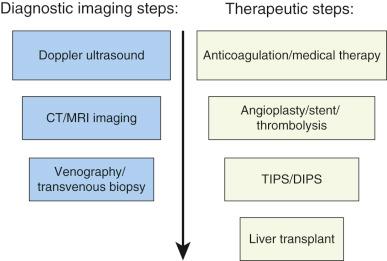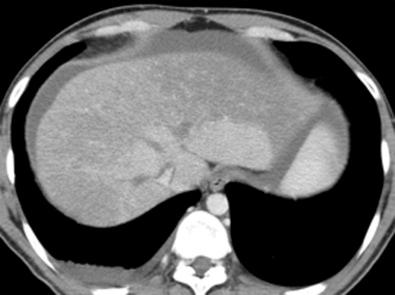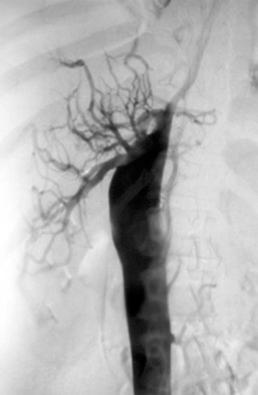Physical Address
304 North Cardinal St.
Dorchester Center, MA 02124
α-fetoprotein
Budd-Chiari syndrome
bone marrow
direct intrahepatic portosystemic shunt
essential thrombocythemia
hepatocellular carcinoma
hematopoietic cell transplantation
hepatic vein
idiopathic myelofibrosis
inferior vena cava
Janus kinase
liver sinusoidal endothelial cells
liver transplantation
myeloproliferative neoplasm
nodular regenerative hyperplasia
polycythemia vera
portal vein thrombosis
sinusoidal obstruction syndrome
transjugular intrahepatic portosystemic shunt
veno-occlusive disease
hepatic veno-occlusive disease with immunodeficiency
This chapter provides an overview of two vascular diseases of the liver: Budd-Chiari syndrome (BCS) and sinusoidal obstruction syndrome (SOS). As they are rare diseases, their diagnosis and management may be a challenge.
BCS is defined as the obstruction of hepatic venous outflow. It is mainly caused by prothrombotic diseases and frequently leads to portal hypertension–related complications. In the majority of cases, it is possible to identify a prothrombotic risk factor as the underlying cause of thrombosis. The clinical presentation of BCS is highly variable and can range from asymptomatic to fulminant hepatic failure. Anticoagulation is mandatory in all patients with BCS. Additional treatment (such as angioplasty, thrombolysis, transjugular intrahepatic portosystemic shunt [TIPS], direct intrahepatic portosystemic shunt [DIPS], surgical shunt or liver transplantation) may be required and depends on the severity of symptoms and response to treatment.
SOS, previously known as hepatic veno-occlusive disease , is the consequence of specific toxins and chemotherapy regimens. Its clinical presentation ranges from asymptomatic disease to severe liver injury with multi-organ failure. Although it is now a rare disease, severe SOS has a high mortality rate.
Budd-Chiari syndrome (BCS) is a rare and life-threatening disease caused by hepatic venous outflow tract obstruction and the term applies to obstruction regardless of the level or mechanism of obstruction. The obstruction can be located anywhere from the small hepatic venules up to the entrance of the inferior vena cava (IVC) into the right atrium. The term hepatic venous outflow tract obstruction (HVOTO) has been used as an alternate to BCS. Hepatic outflow obstruction related to cardiac disease, pericardial disease, or SOS are excluded by definition.
BCS can be classified as primary, when the blockage is intrinsic to the vein (i.e., thrombosis or phlebitis), or as secondary, when the obstruction or compression originates external to the vein (i.e., compression or invasion by a tumor or a benign mass, such as an abscess or cyst). This classification implies differences in etiology, management, and prognosis. This chapter focuses predominantly on primary BCS.
There are limited data available regarding the epidemiology of BCS and it varies according to geographic distribution. Wealthy countries have a lower incidence rate (0.13-0.8 cases per million) compared with countries such as Nepal (2.5 per million inhabitants). There are also geographical differences in type and topography of outflow obstruction. In Western countries, a pure hepatic vein (HV) obstruction is more common, whereas in non-Western countries IVC obstruction is more common. In Western countries, BCS is frequently caused by thrombosis, whereas in Asia and South Africa it is often related to membranous obstruction. Our current understanding is that this membrane is a consequence of thrombus organization rather than a congenital anomaly.
The risk factors for BCS are listed in Table 44-1 . In up to 90% of patients, at least one prothrombotic risk factor is identified, and in up to 46% of patients multiple concurrent risk factors exist. Myeloproliferative neoplasms (MPNs) are the leading causal factor. Polycythemia vera (PV) is the MPN most frequently associated with BCS, whereas essential thrombocythemia (ET) and idiopathic myelofibrosis (IMF) are less common. Other acquired and inherited risk factors are detailed in Table 44-1 . Antiphospholipid antibodies may be primary or related to one of the various connective tissue diseases. Behçet disease is more strongly associated with obstruction of the IVC than with HV thrombosis. Hyperhomocysteinemia and methylene-tetrahydrofolate reductase (MTHFR) gene mutations are weak risk factors for splanchnic thrombosis. Oral contraceptives, pregnancy, and the weeks following childbirth are associated with an increased risk for BCS, most commonly along with a concurrent risk factor. It should be noted that the prevalence of many of these risk factors differs between West and East. Indeed, MPN, Janus kinase 2 (JAK2) V617F mutation, Factor V Leiden and prothrombin gene mutations, and paroxysmal nocturnal hemoglobinuria are uncommon in the Chinese population with BCS.
| Primary Budd-Chiari Syndrome |
| Acquired Prothrombotic Diseases |
|
| Inherited Prothrombotic Diseases |
|
| Other Factors |
|
| Secondary Budd-Chiari Syndrome |
|
* Prevalence of thrombotic risk factors in studies of adult patients without cirrhosis or hepatocellular cancer.
The main causes of secondary BCS include cancers, infections, and, less frequently, posttraumatic intrahepatic hematoma, granulomata due to sarcoidosis, and aspergillosis invading the hepatic veins (see Table 44-1 ).
There is a wide spectrum of disease presentation, ranging from absence of symptoms to fulminant liver failure. The type and severity of symptoms will depend on the extent of the thrombosis, the time-course over which the obstruction develops, and the duration of untreated disease. BCS may present as acute, acute-on-chronic, subacute, or chronic, although the latter two are more common. The most common presenting signs and symptoms are abdominal pain, hepatomegaly, and ascites, followed by lower extremity edema, gastrointestinal bleeding, and hepatic encephalopathy. Patients with an acute presentation are more likely to present with fulminant hepatic failure with encephalopathy, coagulopathy, and renal impairment. Conversely, slower and more progressive obstruction allows the formation of collaterals, alleviating sinusoidal congestion. Thus with extensive formation of collaterals or involvement of a single hepatic vein, symptoms may be mild, liver function may be well preserved, and there may be no ascites. BCS may be asymptomatic in up to 20% of cases and is often associated with the presence of hepatic venous collaterals. In this setting, a history of vague complaints and onset of ascites within the last 6 months is common. In IVC obstruction, patients may develop a subcutaneous collateral circulation across the abdomen, chest, and back. Although this finding is uncommon, it is very specific for IVC block.
Up to 80% of BCS patients have benign regenerative nodules. These are generally multiple, small, hypervascularized, and disseminated throughout the liver, and they may increase in number and in size over time. The current thinking is that the regenerative nodules are the result of heterogeneous perfusion. BCS patients are also at risk for developing hepatocellular carcinoma (HCC) and accurately differentiating between benign nodules and HCC is critical. Guidelines for noninvasive diagnosis of HCC in cirrhosis are not applicable to BCS patients. A French study showed that an α-fetoprotein (AFP) level greater than 15 ng/mL had a positive predictive value of 100% and a negative predictive value of 90% for the diagnosis of HCC in BCS patients. The same study suggested that biopsy should be considered in patients with three nodules or less, nodules with a diameter of 3 cm or more, heterogeneity or washout on the venous phase, changes in two consecutive imaging studies, or increase in AFP levels, but these criteria need to be validated in larger cohort studies. Diagnostic biopsies in this population are complicated by the need to carefully manage anticoagulation.
Portal vein thrombosis (PVT) occurs in approximately 15% of BCS patients. These patients have a higher prevalence of multiple risks factors and their prognosis is worse. Therapeutic options are limited and prognosis tends to be worse in BCS-PVT patients with splenic and/or superior mesenteric vein thrombosis compared with those without.
In almost all cases, the diagnosis of BCS can be established with noninvasive radiologic techniques such as Doppler-ultrasound, CT, or MR-angiography. MRI and CT are recommended for diagnostic confirmation if an experienced sonographer is not available ( Fig. 44-1 ). Imaging demonstrates obstruction of or absence of flow in the major hepatic veins or IVC and presence of intrahepatic, capsular, or systemic collaterals ( Figs. 44-2 and 44-3 ). The hepatic parenchyma may have patchy enhancement due to uneven portal perfusion, the liver surface may be nodular, and the caudate lobe may be hypertrophic. The caudate lobe drains through the right inferior HV into the IVC and this venous drainage thromboses less frequently. Therefore its flow may become an important route of blood flow when there is occlusion of two or all three main HVs. This increased flow leads to caudate lobe hypertrophy. Diagnosis of BCS is excluded if hepatic veins are normal with phasic flow.



Due to improvement in radiologic techniques, the necessity for invasive diagnostic methods (e.g., venography and liver biopsy) is limited to a small number of patients, and only recommended if the diagnosis remains uncertain. Guidelines suggest that biopsy should be considered when imaging has failed to demonstrate obstruction of the large HVs and IVC and the diagnosis of BCS remains suspect, because it is the only method that establishes a diagnosis of BCS of the small intrahepatic veins.
Liver biopsy findings in acute BCS include centrilobular and sometimes midlobular sinusoidal congestion, acute hemorrhage, and hepatocyte ischemia or drop out. Chronic outflow obstruction leads to hepatocyte dropout, bridging fibrosis between central veins with sparing of the portal tracts, nodular regenerative hyperplasia, and ultimately cirrhosis.
BCS may be a manifestation of a blood disease. Therefore a thorough work-up should aim to identify the predisposing hematological factor(s). Because several factors coexist in approximately half of all cases, it is wise to perform a complete etiologic study even after a prothrombotic or local factor has been identified. Diagnosis of MPN may be challenging in these patients as the typical peripheral blood changes may be masked by plasma volume expansion, hypersplenism, and iron deficiency anemia related to portal hypertension. Genetic testing for the JAK2 V617F mutation has facilitated MPN diagnosis. Greater than 90% of patients with PV and approximately 50% of patients with ET and IMF carry the JAK2 V617F mutation. Hence, JAK2 V617F mutation should be tested in all patients with BCS because it increases the probability of diagnosing underlying MPN. However, the presence of this mutation does not define the phenotype of MPN and consequently it is often necessary to perform additional hematologic studies, including bone marrow biopsy/aspiration. Recently, somatic calreticulin mutations have been described in up to 67% and 88% of the JAK2 V617F–negative ET and IMF, respectively. It is present in up to 1.9% of patients with splanchnic venous thrombosis, representing up to a 5.4% of the MPN in this setting. In those patients in whom JAK2 V617F mutation is undetectable, further tests (i.e., calreticulin mutation) may detect additional cases of MPN.
The diagnosis of protein C, protein S or antithrombin deficiencies may be complicated, because their synthesis decreases even prior to loss of hepatic synthetic function. Studies of family members may be helpful to diagnose these disorders in BCS patients.
According to recent guidelines, the sequential steps for management are:
anticoagulation, treatment of underlying prothrombotic diseases, and management of portal hypertension related complications
treatment of short-length venous stenoses amenable to angioplasty and/or stenting
TIPS or DIPS, if angioplasty or stenting is not possible or unsuccessful
liver transplantation if TIPS/DIPS is unsuccessful or the patient does not improve despite it (see Fig. 44-1 ).
The current drawback of BCS management is the lack of well-defined criteria for “treatment failure” to step-up in treatment. Previously reported criteria for treatment failure were the occurrence of any of the following that cannot be explained by other cause after at least 2 weeks of adequate medical treatment: patients with ascites requiring paracentesis, development of spontaneous bacterial peritonitis, progressive renal failure, an episode of variceal bleeding or of hepatic encephalopathy and/or further deterioration in liver function and/or persistent transaminases greater than 300 IU/mL. However, these criteria are empiric and have not been validated.
Become a Clinical Tree membership for Full access and enjoy Unlimited articles
If you are a member. Log in here